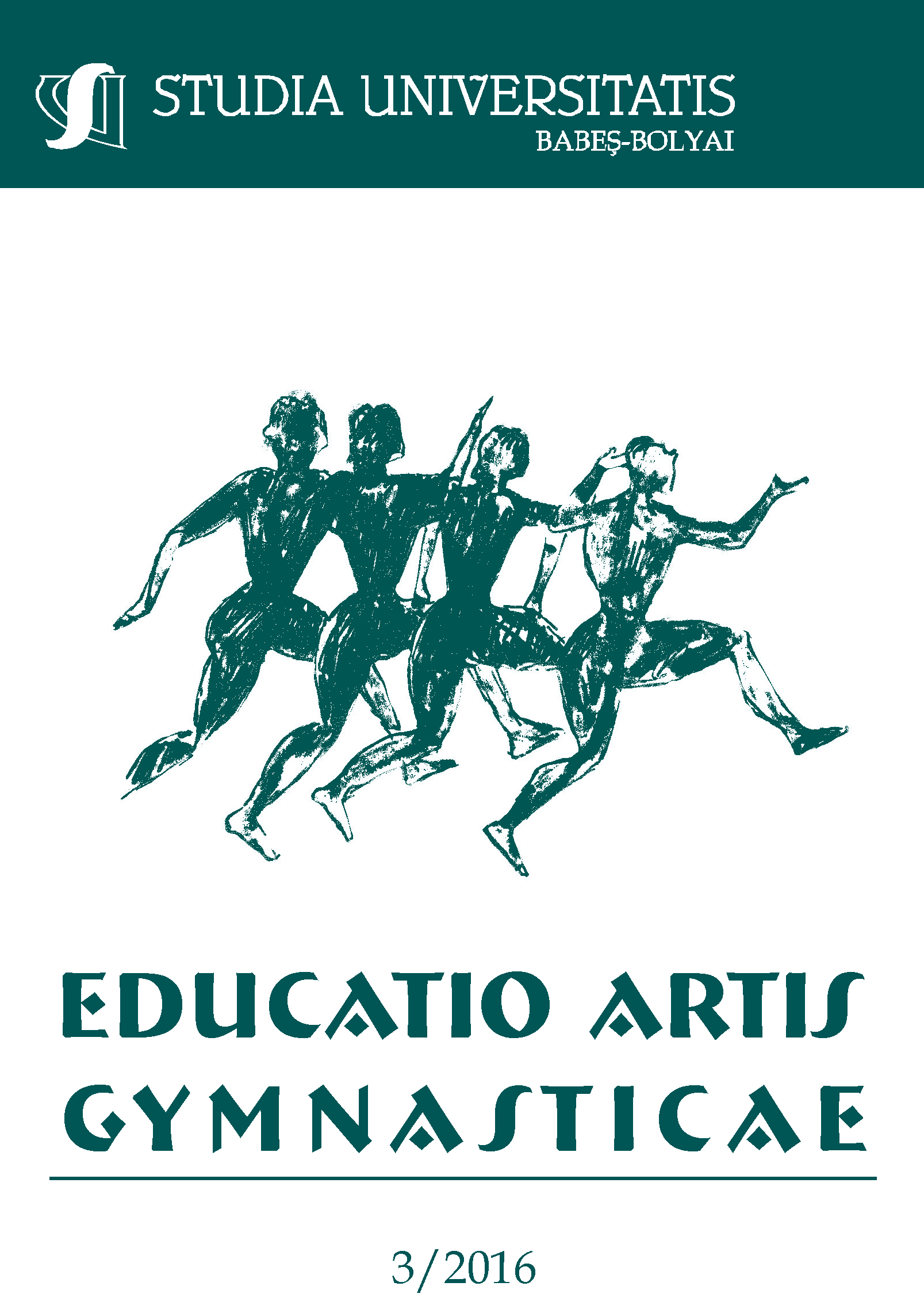THE NUTRITIONAL STATUS OF A CATEGORY I JUNIOR HANDBALL TEAM IN TRAINING
Keywords:
sports diet, professional sports, sports nutrition, food regime, dietetics, handballAbstract
Introduction. Youth is the optimal period for healthy physical exercise, as well as performance sports. One achieves harmonious physical and mental development through these means. Nevertheless, the conditions of modern life, with its numerous temptations and food industry novelties, as well as the change in traditional eating frequency and habits are responsible for nutritional deficiencies or excess of potentially anti-nutritional substances. Since the speciality literature on this topic has only been studied to a small extent, we have considered evaluating the nutritional status of professional athletes. Objectives. The main objective of this research has been to investigate the nutritional status and its consequences, in the case of professional handball players (junior I team – males). Methods. While investigating the nutritional status, we have used standard protocol, involving several components: eating intervals (generating data that pertain to food behaviour and preferences), analysis of food intake (this uses data provided by the food inquiry and the structure of the food rations), anthropometry and biochemical analyses. Results. Based on anthropometrical measurements, we have found that the lot is homogenous, with excess adipose tissue comparable to the upper limit of normality. Within the handball team, following detailed research, we have discovered that there are eight harmoniously developed players, and seven disharmonious ones, a diagnostic set by using BMI, excess adipose tissue and active muscle mass. With regard to biochemical analyses, the lot is considered to be within normal parameters, given the tests performed. Conclusions. Within the handball team, eight players are harmoniously developed, while seven are disharmonious. The average value of biochemical parameters is normal. The average value of the total caloric intake of handball players during training period is 4330.14 ± 340.69 kcal/day. The synthesis of the food rations structure of the handball team is: protein participation 13.46%, fat 34.30% and carbohydrates 52.24%. Fats of vegetable origin account for 50.11%, while animal ones stand at 49.89, i.e. below recommended levels.Evaluarea stării de nutriție la lotul de handbal categoria juniori I în perioada de antrenament. Introducere. Tinerețea este perioada optimă pentru mișcare fizică sănătoasă, chiar sport de performanță. Este o modalitate prin care se obține o dezvoltare armonioasă, fizică și psihică. Dar condițiile vieții moderne, cu multiplele ei tentații și noutăți comerciale alimentare, precum și modificarea frecvenței și obiceiurilor alimentare tradiționale sunt responsabile de carențe nutriționale sau exces de substanțe cu potențial antinutritiv. Pentru că în literatura de specialitate a fost lacunar studiată, ne-am gândit să evaluăm starea de nutriție a sportivilor de performanță. Obiective. Scopul principal al acestei cercetări, a fost de a se investiga starea de nutriție și consecințele ei pentru sportivii care practică handbal de performanță (categoria junior I masculin) Metode. În investigarea stării de nutriție s-a utilizat un protocol standard, care presupune mai multe componente: interviul nutrițional (aduce informații referitoare la comportamentul alimentar, preferințele alimentare), analiza aportului alimentar (utilizează datele oferite de ancheta alimentară și structura rației alimentare), antropometria și analize biochimice. Rezultate. Pe baza măsurătorilor antropometrice s-a constatat faptul ca avem un lot omogen, cu țesut adipos excedentar față de limita superioară a normalului. În cadrul lotului de handbal, după cercetări amănunțite s-a descoperit că există 8 sportivi dezvoltați armonic, iar 7 dizarmonic, diagnostic stabilit prin utilizarea IMC, surplus de țesut adipos și masă musculară activă. Referitor la analizele biochimice putem spune că avem un lot care se află între parametrii normali după testările efectuate. Concluzii. În cadrul lotului de handbal 8 sportivi sunt dezvoltați armonic, iar 7 disarmonic. Valoarea medie parametrilor biochimici este normală. Valoarea medie a aportului caloric total al handbaliștilor din perioada de antrenament este de 4330,14 ± 340,69 kcal/zi. Sinteza structurii rației alimentare a lotului de handbal din perioada de antrenament este: participare proteică 13,46%, lipidică 34,30% și glucidică 52,24%. Lipidele de origine vegetale reprezintă 50,11%, iar cele de origine animală 49,89% fiind sub recomandări. Cuvinte-cheie: diete sportive, sporturi profesioniste, nutriție sportivă, regim alimentar, dietă, handbal.
References
Damian S. (2006) Superfit. Esențialul în fitness și culturism, Bucharest: Ed. Corint.
Dragnea A. (1984) Măsurarea și evaluarea în educația fizică și sport. Bucharest: Ed. Sport Turism.
Drăgan I. (1974) Medicina sportivă, Bucharest: Ed. Stadion.
Drăgan I. (1989) Practica medicinii sportive, Bucharest: Ed. Medicala.
Drăgan I. (1994) Medicină sportivă aplicată, Bucharest: Ed. Editis.
Drăgan I. (2002) Medicina sportiva, Bucharest: Ed. Medicala.
Hâncu N., Roman G. & Veresiu I.A. (2010) Diabetul zaharat. nutriție și boli metabolice, Cluj-Napoca: Ed. Echinox; 2:612-616.
Hâncu N., Niță C. & Crăciun A. (2012) Abecedar de nutriție, Bucharest: Sănătate Press Group.
Muraru A. (2004) Ghidul Antrenorului I and II, Bucharest: Ed. Proxima.
Muraru A. (2005) Ghidul antrenorului IV, Bucharest: Ed. Proxima.
Riche D. (2007) Nutriția și medicina sportivă, ANS, High Performance Sports Collection, 1:31.
Simu D., Roman G. & Szilagy I. (2000), Ghidul nutriției și alimentației optime. Cluj-Napoca: Ed. Dacia.
Spagnoli F. (2004 July). Sportul începe întodeauna la masă, Sport și Sănătate Journal, 0:71-84.
Talbott S.M. (2003) A Guide to Understand Dietary Supplements, Binghampton, NY: Haworth Press.
Williams M.H. (2004 December). Dietary Supplements and Sports Performance. Introduction and Vitamins, J Int Soc Sports Nutr. 1:1-6.
Zamora E. & Crăciun DD. (1999) Igiena educației fizice și sportului, 1st Edition, Cluj-Napoca: Ed. Risoprint.
Downloads
Published
How to Cite
Issue
Section
License
Copyright (c) 2016 Studia Universitatis Babeș-Bolyai Educatio Artis Gymnasticae

This work is licensed under a Creative Commons Attribution-NonCommercial-NoDerivatives 4.0 International License.



